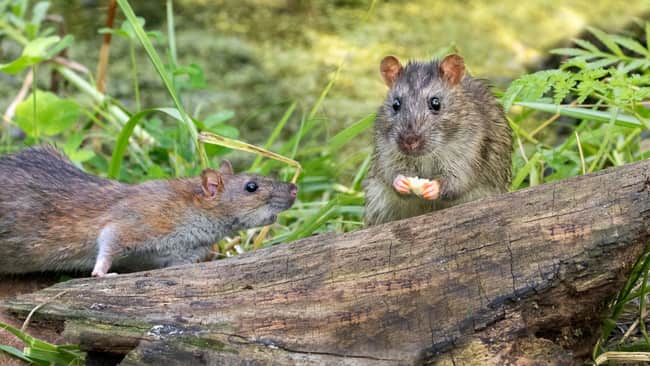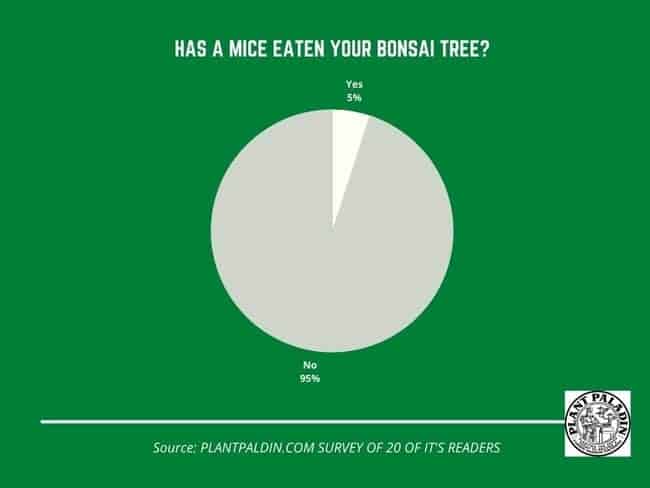This website is supported by its readers. If you click one of my links I may earn a commission. I am also a participant in the Amazon affiliates program and I will also earn a commission from qualified purchases.

A rat infestation is one of the worst types of pests that you can have. The noise and damage caused by these are often a lot more significant than other rodents such as mice. So what exactly is the effect that rats have on bonsai trees, do rats eat bonsai trees?
Rats will eat and severely damage bonsai trees. Rats will eat the bark, leaves, and fruit in particular. They tend to eat bonsai trees during the winter when other food sources, such as seeds or grains, are hard to come by.
So why do rats eat bonsai trees? What can you do to prevent rats from eating your bonsai? Keep reading to find out more.
Many of you reading this might also be struggling with mice eating your bonsai tree – if this is the case check out this post here.
Just a quick heads up, over the past three years of running Plantpaladin, hundreds of people have asked for product recommendations. As such, You can find my favorite indoor bonsai tree here (link takes you to Bonsaiboy), my favorite outdoor bonsai tree (link takes you to Bonsaiboy), or have a look at all the products I recommend here.
Do rats eat bonsai trees?
Rat infestations are on the rise.
Lockdown restrictions have meant some exterminators seeing a massive 42% year-on-year rise of rodent infestations.
Any kind of pest infestation is worrisome for us bonsai keepers.
Rats in particular due to their size can cause significant damage to bonsai trees, often killing or significantly damaging them.
As such, I visited my local botanical gardens, did a quick survey of 20 plant paladin readers, and even called up a local exterminator to find out exactly why rats eat bonsai trees?
Here is what I found:
- Rats will eat bonsai trees
- In particular, rats will eat the leaves, bark, fruit, and flowers of bonsai trees.
- Rats will tend to eat bonsai during the winter months when their regular food sources of seeds and grains are harder to come by.
- City rats in particular will cause the most damage to bonsai trees, this is because, unlike their rural counterparts, city rats are much more akin to meat and will often look for the easiest meal they can find.
- It is not uncommon then for rats to break into greenhouses or bonsai cold frames and eat bonsai trees.
- Left unchecked rats can eat the entirety of a bonsai tree – it is not uncommon for bonsai owners to pack their bonsai away for winter only to check on them for the spring and be completely eaten.
- Rats also carry a myriad of diseases that can impact the health of people and bonsai trees alike so it is important you try and deal with these issues.
What type of rats cause the biggest damage to bonsai?
City rats will cause the biggest problems with bonsai trees. This is because the city rats are often larger and more aggressive than their rural counterparts and will be more likely to cause damage and eat a bonsai tree in its entirety.
Why do rats eat bonsai trees?
Rats by their nature are scavengers and should they come across a bonsai tree they will eat it. Should your bonsai tree produce flowers or fruit then rats will also see this as a free meal and damage your bonsai tree in the process.
How to stop rats from eating bonsai trees?
If you are suffering from rats eating your bonsai trees, there are a few solutions you can follow to prevent this from happening in the future.
Keep rat traps near your bonsai trees, invest in a good rat poison call up pest control, and ensure you keep your bonsai tree in stainless steel, cast iron, or strengthened aluminum cold frame for the winter to stop rats eating your bonsai.
Predatory animals can also be used.
Let’s explore these in more detail.
Invest in traps
One of the best options you can do to prevent rats from eating your bonsai is to simply lay down some sticky traps around your bonsai tree pots.
These traps need to be kept all-around your bonsai tree, preventing rats from eating your bonsai tree at any angle.
Rats are incredibly clever and will learn from their past mistakes so ensure that your bonsai is completely covered.
Now I prefer to use sticky traps as I find that they work best, however, if you prefer you can also opt for traditional spring-loaded rat traps.
Keep your bonsai high
Some studies have found that rats can jump up to 4 feet in the air.
This means that should you keep your bonsai tree outdoors in a nursery, reaching it will be easy enough through jumping let alone should the rat climb on your bonsai bench.
As such, aim to keep your bonsai tree in a hard-to-reach high area that has no way of the rat climbing and reaching your tree.
Whilst they can be a little bit tricky to use, I’ve found that using things like hanging baskets as a temporary solution also works well.
Keep your bonsai indoors
Whilst not all bonsai species are suitable to be kept indoors (such as maples or deciduous species who need a lot of water and sunlight needs) other bonsai are primed for indoor living, Chinese elm or ficus bonsai, in particular, have been known to thrive indoors.
Rats are often found a lot less commonly indoors than outdoors when compared to other rodents like mice so to avoid rats, simply move your bonsai indoors.
Invest in dry ice
Another fantastic option to destroy rice near and around your bonsai is by investing in dry ice.
Dry ice is commonly used by the likes of exterminators as a more humane way to deal with rats than using things such as poisons or traps.
Keeping a few blocks of dry ice near your bonsai then will release a lot of co2 in the air, exterminating any nearby rats in the process.
This is especially true should your bonsai tree be nestled near a rat’s nest.
Build a metal cold frame
More often than not, rats will attack bonsai trees during the winter months, when their other food sources such as grains have dried up.
It’s not uncommon then for bonsai owners to store three bonsai trees in garages or polystyrene cold frame for winter only to check up on their trees and notice that the branches and bark have been shriveled up and eaten by rats.
One of the best things you can do then if you do need to store your bonsai trees away for winter is to build a bonsai cold frame out of steel, aluminum, or cast iron – these materials whilst often chewed by rats, won’t be able to be penetrated by them.
I found that often investing in something like a file cabinet does a fantastic job.
Now when building a cold frame you will need to have some holes to help maintain the temperature of your tree.
| Material | Will rats be able to chew through? |
| Cast iron | No |
| Stainless Steel | No |
| 316 Stainless steel | No |
| Aluminum | Yes |
| Oak | Yes |
| Plywood | Yes |
| MDF | Yes |
| Plastic | Yes |
Bonsai greenhouses are another good option – although rats have been found to chew through glass, just be sure that if you do keep your bonsai tree in a greenhouse that you keep any doors or holes closed.
Invest in predators
Cats are the natural predators of rats
Should you find an increased infestation then consider keeping cats to help you hunt rats and keep them from your bonsai trees.
Just be warned however that animals like cats and dogs can get sick eating bonsai trees so you will need to be vigilant.
Now if you keep a large bonsai collection outdoors then consider a natural predator like an owl or other birds that will easily take care of rats from eating your bonsai.
Call an exterminator
If you have tried the above methods and nothing is working then it might be time to call up an exterminator and get them to help use rat poison.
Rat poison works very well at stopping and killing rats, preventing them from eating your bonsai trees.
An exterminator will usually place this around your house, apartment, or garden, in the spots they suspect the rats to be coming from.
You can also tell them to lay a few pellets down in the topsoil of your Bonsai.
Just be warned that if you do decide to opt for this method, you do not use it if you have pets or young children who can be susceptible to eating the pellets.
Remove insects
Whilst rats are usually omnivores, they have been found to eat insects such as grasshoppers or caterpillars.
As such, it’s important to avoid any insects from your bonsai tree, giving the rats less of a banquet to feast on in and around your plant.
I found that using a solution of 2 tablespoons of liquid soap with 30 oz of water usually works best for this.

For a full guide, check out my post or removing insects here for checking out the following posts:
- Aphids on bonsai
- Do caterpillars eat bonsai
- Do frogs eat bonsai trees
- Bonsai trees and birds
- Do slugs eat bonsai trees
- Scale on bonsai
- Spider-mites on bonsai
Get larger bonsai
Keeping smaller-sized bonsai such as fingertip bonsai, or bonsai cuttings and seedlings will mean there is a higher chance for rats to eat or damage the entirety of your tree.
Keeping a large-sized bonsai then means should a rat come calling and eat the bark or cambium on your tree, the rest of the tree will hopefully be left intact.
What part of bonsai trees do rats eat?
Rats will eat the fruit, leaves, bark, flowers, and seeds of bonsai trees. Smaller bonsai cuttings and seedlings are more at risk of being eaten by rats. Bonsai trees with more leaves or more branches such as maple will be more likely to be eaten.
Rats will also eat and gnaw at the parts of the bonsai trees that are easiest for them to reach.
As such it is more common for ears to chew the base of a bonsai trunk near the topsoil – especially if your bonsai tree is planted in the ground.
Do rats eat bonsai pots?
Rats will eat and chew anything they come across. This will include bonsai pots alongside the bonsai trees that reside inside them. To avoid rats eating your bonsai pots consider investing in a thickened glass or steel pot that cannot be eaten by rats.
Are rats or mice more dangerous to bonsai?
Rats are more dangerous to bonsai than mice. This is because whilst mice might chew and gnaw a bonsai tree, rats can consume the entire tree relatively easily.
As such, it’s very important that you try to rat-proof your bonsai trees by insulating them as much as possible.
Keeping them higher than 4 feet which rats have been known to jump.
Do rats eat the moss of bonsai?
Rats will eat all parts of bonsai trees. This includes any mosses such as sphagnum moss used for the cultivation of your tree. Mosses in particular can hold significant amounts of moisture making them perfect for rats and rodents to consume.
Are bonsai trees poisonous to rats?
Pine species of bonsai such as cedar white pine or jumper are toxic to rats. Pine species in particular and pine oil have been known to have adverse effects on rats. This however will not stop rats from eating pine bonsai.
What happens if you do not remove rats from bonsai trees?
Rats have been known to carry several diseases and fungi that can damage bonsai trees. It is not uncommon for bonsai trees to develop fungal infections, usually displayed by white spots on bonsai leaves, after interacting with rats.
What bonsai species do rats like to eat?
Rats will eat almost all species of bonsai tree. They do tend to eat leafy, deciduous bonsai tree species such as maples trees, ficus, or elm trees. Rats will avoid oak bonsai trees as they are toxic.
Do rats eat bonsai trees? Survey
Now I didn’t want to just highlight my findings of if rats eat bonsai trees but wanted to give a few other experts advice.
First I got in touch with my local council and asked them if rats eat bonsai trees – here was their response:
“Mice and rats are opportune and will eat anything given the opportunity.”
Finally, I asked 20 plant paladin readers their thoughts on if mice/rats and other rodents had eaten their bonsai trees – here were the results:

A lot of you reading this will be new to keeping bonsai so I would recommend you check out the following posts:
- Bonsai trees and rainwater
- Bonsai trees and sunlight
- Sacrifice bonsai branch
- How to use bonsai humidity trays
- How long do bonsai trees live
- Are bonsai trees toxic
My top picks for the gear you will need!
So like I mentioned earlier, over the past three years of running PlantPaladin, hundreds of people have asked me for my recommendations on the best bonsai gear on the market.
Having spent thousands of dollars on bonsai items these past few years and tested at least 100 bonsai-specific products, I’ve listed my favorite products below – All of which I highly recommend and think you can get great value.
They can purchase directly by clicking the link to take them to Amazon.
Bonsai Tool Set: One of the significant challenges I’ve had is finding a toolset that was not only durable but didn’t break the bank. SOLIGT has recently developed a fantastic bonsai tool set that covers all the tools you need to trim, prune, and repot your trees. – You can grab it here.
Complete Bonsai Set: Many of you will want to grow your bonsai trees entirely from scratch, but finding the varicose seeds, pots, and other items in one place can be challenging. Leaves and Sole then have created a complete bonsai set that I’ve personally used that ticks all the boxes. You can grab it here.
Bonsai wire: The number of times I’ve run out of wire for my bonsai or purchased cheap bonsai wire that doesn’t do the job is embarrassing for me to admit. After a lot of trial and error, I found that using Hotop’s aluminum bonsai wire is one of the best options on the market. This can easily be used for both indoor and outdoor bonsai. You can grab it here.
This post was written by Fehed Nicass who has been passionate about bonsai for over 2 years. He currently resides in the UK and works in sales.

